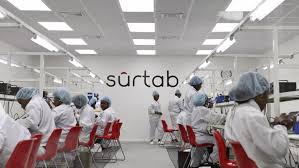Tablet computers point way to a different economic path for post-earthquake Haiti
Tablet computers are probably not the first product that springs to mind when Haiti is mentioned. And yet that is exactly what Sûrtab, a tech company founded in 2013 by four entrepreneurs (Maarten Boute, Richard Coles, JP Folsgaard Bak and Ulla Bak) are producing.
 Belgian-born Boute, Sûrtab’s CEO, told Tate Watkins of Medium for Haiti that Sûrtab is part of an effort to ‘re-establish Haiti as a destination for appliances and electronics manufacturing’.
Belgian-born Boute, Sûrtab’s CEO, told Tate Watkins of Medium for Haiti that Sûrtab is part of an effort to ‘re-establish Haiti as a destination for appliances and electronics manufacturing’. According to Sûrtab’s own website, the name combines the French term ‘Sûr’ which ‘is used to designate things which are emphatic, certain, and true’ with a contraction of the English word ‘tablet’.
Since it was founded with the help of a US$200,000 start-up grant from the US Agency for International Development (USAID), Sûrtab’s production has gradually increased.
Sûrtab’s website states that the company has been producing about 3,000 tablets a month but is looking to increase that to 7,000. The components are Chinese and are assembled in Sûrtab’s facility on the SONAPI industrial park near Port-au-Prince’s airport.
As well as the start-up grant from USAID, the company has also benefited from a five-year exemption from duty and employee taxes granted them by the Haitian government.
Sûrtab’s Markets
Sûrtab produces three models of its Android Sûrtab7 tablet – a base level Wi-Fi version, a 3G version, and a 3G version with an HD screen. The base version retails for about US$85, while the two 3G versions sell for about US$150 and US$285 respectively.
The tablets, which are being sold through Digicel outlets, are targeted at Haiti’s small consumer class. Boute was Digicel Haiti’s CEO before becoming involved in Sûrtab.
While the domestic market accounts for about 90 percent of its sales, Sûrtab has looked to export its producs abroad and has targeted countries within Latin America and the Caribbean, and within the global south.
Sûrtab has supplied tablets to a law school in Kenya and an educational foundation in Jamaica.
The company also plans to start exporting to the US, Canada and Europe. The Sûrtab website states that the company intends to make their product range available online for customers in these markets before June 2014.
Sûrtab and Haiti’s Tech History
Although not nowadays associated with technology manufacturing, it does appear that this is an area the government is keen to develop. In a country in which internet penetration is low, standing at about 11 percent, there is clearly work to be done.
On a trip to Silicon Valley in California at the end of last year, Prime Minister Laurent Lamothe outlined his vision of an increasingly “wired” Haiti. ‘Technology’, he said, ‘can help us bridge the development barrier we have today’.
Though Haiti is associated with garment manufacturing and the production of baseballs rather than technology and electronics, this was not always the case.
In his book Politics or Markets?Essays in Haitian Underdevelopment, Mats Lundhal points to the emergence of a significant assembly sector in the 1970s, part of which involved electronics and, in particular, the assembly of computer boards.
Lundahl writes that ‘Without doubt, assembly manufacturing was the most dynamic spot in the Haitian economy from 1970 to the mid-1980s’.
Haiti’s manufacturing industries declined as a result of political instability following the ouster of the dictator Jean Claude ‘Baby Doc’ Duvalier in 1986.
A UN-backed embargo instituted in the early 1990s designed to undermine the military junta led by Raoul Cédras further hampered Haiti’s electronics industry and saw many of the companies involved pull out of the country.
Sûrtab and Tech Haiti
It is too early to suggest that Sûrtab represents the beginnings of a sea-change within the Haitian economy, as Haitian manufacturing is still very much geared towards the production of T-shirts and other garments.
The Caracol Industrial Park, which is geared towards garment production, is emblematic of this – although as the Haiti Support Group have suggested (in an article subsequently published by LAB) only 2000 of the promised 65,000 jobs have actually come about and the wages that are paid are below the minimum wage.
High-value technology offers an alternative route towards industrial development – albeit one that would require investment and government help to surmount some of the logistical and infrastructural problems that can hinder companies doing business in Haiti.
This does not mean that technology is about to supplant garment production. Technology manufacturing cannot create the volume of jobs to make a significant dent in Haiti’s high unemployment rate. Sûrtab only employs about 50 people at the moment, although those employees are well paid by Haitian standards. Nevertheless, garment manufacturing is more suited to mass job creation.
According to Diderot Musset, Sûrtab’s production manager, while it might be the case that garment production generates jobs, ‘in terms of added value to the country as a whole […] this is a better deal’.
Haiti is often depicted as a country with enormous problems. Sûrtab stands as an important symbol of Haitian possibility. As Boute told The Guardian in February 2014: ‘Everyone knows Haiti, but for the wrong reasons. Now Sûrtab associates the Haiti brand with something cool’.

